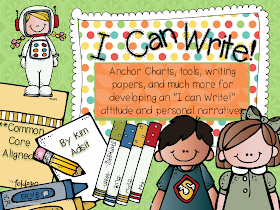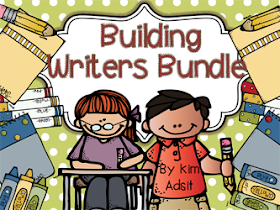Each month we teach a different genre of writing. If you have been following along, you know that during writer's workshop we are not assigning topics and writing about themes. Instead, we are teaching the craft of writing. How do writers do it!
At the end of each month, we assess our kids using a rubric like the one above. These scores are sent to our assistant principal. She can use them to make decisions about where we need to go as a school. She sends them to the central office so that can make decision at the district level. These are formative assessments for them---they help them plan their next step. But, for us, it is a summative assessment. How does it benefit you? Well, you can use it to help you know what to do differently next year, but for these kids it's really not very helpful. Tomorrow we will be moving to a new genre, leaving this one behind. (We do revisit genres through science and social studies, but this is the end of the concentrated study of personal narratives.)
I wanted to use the rubric as a way to determine what I needed to teach and who I needed to teach it to. I decided to do a "mock assessment". In the middle of the unit, I took up a writing sample from each child. I scored it using the rubric. Now, I'm getting somewhere! If I had a lot of 3's on a particular item on the rubric, I would know that I had taught that part pretty well. The children not making a 3 could be pulled into a small conference group to work on that particular point. If I had a lot of 2's and maybe even some 1's, I would know that I needed to continue to teach that during my mini lessons. Maybe I really hadn't covered that point yet. If I THOUGHT I had covered that point, then maybe I need to revisit my approach. It obviously wasn't effective.I decided to put my rubric on a chart to display in the room. I did this for a few reasons.
- It helps me keep me lessons focused on the end goal. Begin with the end in mind.
- It reminds me to show my children what is expected in their writing.
- It helps kids, and me, see the connection between the mini lessons and the rubric.
- It lets the kids know what I am looking for in their writing.
- It makes us "talk" like writers.
As you can see, the rubric has 5 key points.
- Parts 1 and 2 address the actual writing standard. I can use the scores on these two items to mark the writing standard on the report card. These two scores to me are the most important! We are teaching that genre for a very specific time. It is essential that the child masters the elements of each genre.
- Parts 3 and 4 address the foundational skills. "Help the reader" refers to the child's ability to apply foundational skills. Depending on the time of year, this could be uses dominant sounds, uses spaces between words, use the word wall and other resources, uses punctuation, etc. While children will move through these at different rates, it is helpful to know the benchmark for each month. Then, you can use that to help you mark the report card.
- Part 5 address the speaking and listening standards. These standards are often overlooked. However, adults who lack the ability to engage in peer to peer conversations, talk about grade level topics, etc., often struggle in their professions. This part of the rubric is easily assessed during share time!
Let's look at some of our writings. Child 1: This child's story was about going on a trip, in a car, with their family. They were in the car a long, long time.
- You can see I gave them a 3 on the writing standard. They were able to tell me their story and it included both characters and a setting.
- On the foundational skills, the children isn't using any form of text, so she received a 1. She did get a 2 on help the reader, because she had good detail in her illustration even though she wasn't using text.
- On the speaking and listening standards, she received a 3. She was able to tell her story and engage in a conversation with her peers about her trip.
- She received a 3 and a 2 on the writing standard portion. Her illustration is missing the characters in her story. When she told her story, she did include the characters, but we want her to include them in her illustration since that is where the reader is getting the information.
- She received a 2 and a 3 on the foundational skills. She is using beginning and ending sounds, but not other dominant sounds within the word. She was helpful to the reader by adding letters to help them know each part of the story, and her illustration contains details.
- She received a 3 on the speaking and listening for her ability to tell her story and engage in conversation.
Here's the last one. This child's piece was about his dad helping him learn to ride his bike.
He received all 3's. This child has mastered all of the genre, foundational skills, and the speaking and listening standards.
Using a rubric is a great way to assess children. It provides me with the necessary information to drive my instruction. Ever heard, "Data driven instruction?" Does it make you want to say a bad word? Well, that is all there is to it! Rubrics are a great way to collect data that you use to drive your instruction! Simple as 1,2,3!
The rubric for personal narratives is in this unit.
Or in this bundle.










No comments:
Post a Comment
Note: Only a member of this blog may post a comment.